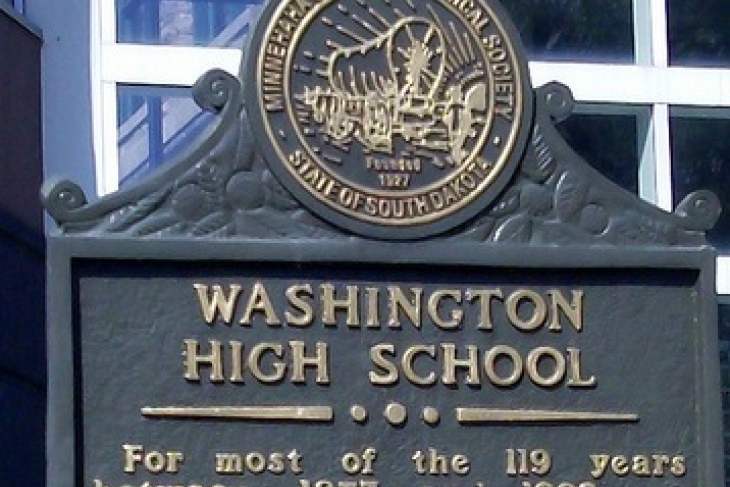I taught fifth grade for many years at P.S. 277, in New York City’s South Bronx. But the school's full name was the Dr. Evelina Lopez-Antonetty Children's Literacy Center. I'd wager heavily there's not a student in that elementary school, or more than two or three adults, who could tell you a single fact about Lopez-Antonetty, whose name is on the door they walk through every morning and whose portrait (last time I looked) hangs in the school auditorium. I always found this odd and irksome. If it's important enough to put someone's name on a public building, it should be important enough to know why.
In the wake of the horrific, racially motivated shooting at the Emanuel African Methodist Episcopal Church in Charleston, there have been demands to remove the Confederate battle flag from the capitol grounds in Charleston and wherever else it appears. Activists are demanding the removal of statues of Confederate Civil War figures and the rechristening of roads, bridges, and military bases bearing their names. There are nearly two hundred K–12 schools in America named after Confederate leaders, and now the calls have begun to strip the names from those buildings as well.
I don't have the standing to tell people in schools I will never see or set foot in which names their institutions are fit to bear. But as a teacher of civics and history, I know a good teachable moment when I see one. So here's a challenge for every school in this country named after a president, military figure, athlete, civic leader, or any prominent person: Commit the coming school year to a close examination of the life and work of your school's namesake. For starters, there's no excuse for ignorance. And your students might learn something—good, bad or ugly—that will create a sense of pride or discomfort. At the very least, it will provide a first-rate lesson in history, civics, and the democratic process to an education system that could certainly use one. A good example of the troubles that come with namesakes arose two years ago in Salinas, California, where a bitter debate erupted over plans to name a school after the notorious Old West bandito Tiburcio Vasquez. The name stood.
Local school boards should encourage this work, and even commission it. But the lift should be put on students. Have them research and write about the person whose name they wear on their school gear and sports uniforms. Let them debate, defend, or challenge the merits of their namesakes—but from a position of deep, informed conviction. Invite speakers from the community, historians, and living family members of each school's namesake (if available) to make cases for and against honoring the man or woman whose name sits above the door. Hold student-run town halls and public meetings. Schedule a public referendum to allow all stakeholders a vote. At every step, let students drive the debate. No one should be more invested in an historical figure than the students who will be linked to those names for the rest of their lives.
But let me also offer a twist: A parallel effort should be made to identify a local or historical figure whose life and work makes them worthy of putting his or her name on the school. Agree that the current name must stand until or unless an alternative person—not a street, natural feature or other bland, inoffensive name like Valley View High—is chosen, should the current honoree fail to pass muster. In a 2007 paper, Jay P. Greene, Brian Kisida, and Jonathan Butcher found that it's increasingly rare for public schools to be named for people at all. Rather they tend to be named after hills, lakes, or animals. In Florida, Greene and his colleagues found, only five of the state's three thousand public schools bear George Washington's name. By contrast, eleven are named for manatees. In Arizona, as many public schools are named for the roadrunner as for Thomas Jefferson.
"Unfortunately, such caution betrays public education's civic mission," Greene and his colleagues wrote. "To teach civics effectively, we have to affirm that democracy and liberty are superior to other systems of government and that the history of democratic societies—shaped by the leadership of people whose names we should know—reinforces this point. If we can't agree on a school name less innocuous than a creek, what are the odds that schools will teach, say, the importance of the Founders or take a stand on the virtues of liberty?"
Data from the National Assessment of Education Progress shows that in 2014, 18 percent of eighth-graders performed at or above the "proficient" level in U.S. history, while 23 percent performed at or above proficient in civics. These levels make our desultory performance in reading and math on the same exams look strong by comparison. What it suggests, to be blunt, is that the average student in one of the nation's eight schools named for Stonewall Jackson probably can't tell you the difference between Stonewall and Samuel L. Jackson. Let's not squander a good controversy and keep kids wallowing in historical ignorance.
If local control of education means anything, it should mean empowering all members of a community—but especially students—to look closely, unblinkingly, at their namesakes' lives and legacies. Expect it to be messy, loud, and contentious. It might also be the most powerful lesson in civics, citizenship, history and community identity that a school will ever undertake. Do it.
Editor's note: This post has been updated to include the entirety of "Want to change school names? Involve students in the decision"

